March 20, 2013, is a day I will never forget. On that day, we performed the first two transcatheter aortic valve replacement (TAVR) procedures at UT Southwestern.
Only a decade ago, there was little that could be done for high-risk and inoperable patients suffering from severe aortic stenosis, which is a narrowing of the heart's aortic valve resulting in the obstruction of blood flow to the body.
Now, we have a pioneering minimally invasive procedure that can significantly improve patients’ lives.
Who is a good candidate for TAVR?
The TAVR procedure is for patients who are not eligible for traditional aortic valve surgery – because of age, previous open-heart surgery, or the presence of multiple medical problems – or who are otherwise high-risk for traditional surgery. Most people who are candidates for this procedure are in their 70s or 80s and often have other medical conditions that limit their options for repair of their aortic valve.
What is the TAVR procedure?

The transcatheter aortic valve replacement (TAVR) procedure is performed by inserting a catheter through the groin to make a repair to the aortic valve. It is a far less invasive alternative to open-heart surgery.
Instead of entering the chest cavity surgically to replace the faulty heart valve, the TAVR procedure uses a catheter to reach the valve. We typically insert the catheter into an artery in the groin and thread the catheter up to the affected valve, which we replace from inside the artery itself.
Because no major incision is made in the chest with the TAVR procedure and because the patient does not have to spend time on a heart-lung bypass machine, trauma to the body is minimal and recovery and healing times are dramatically reduced.
After our patients have received a new heart valve through the TAVR procedure, we see them breathe easier and lead an overall higher quality of life – and they can begin to lead that better life sooner and with less pain.
The future of TAVR
Even though TAVR is a leading-edge medical technology, we can already see exciting developments on the horizon. Currently, teams in Europe are developing even smaller catheters for the procedure. As the catheter size is reduced, recovery time improves even more.
We’ve come a long way since that day in 2013. To date, UT Southwestern’s TAVR team – which includes cardiologists, cardiac surgeons, anesthesiologists, and others – has performed nearly 60 successful TAVR procedures.










